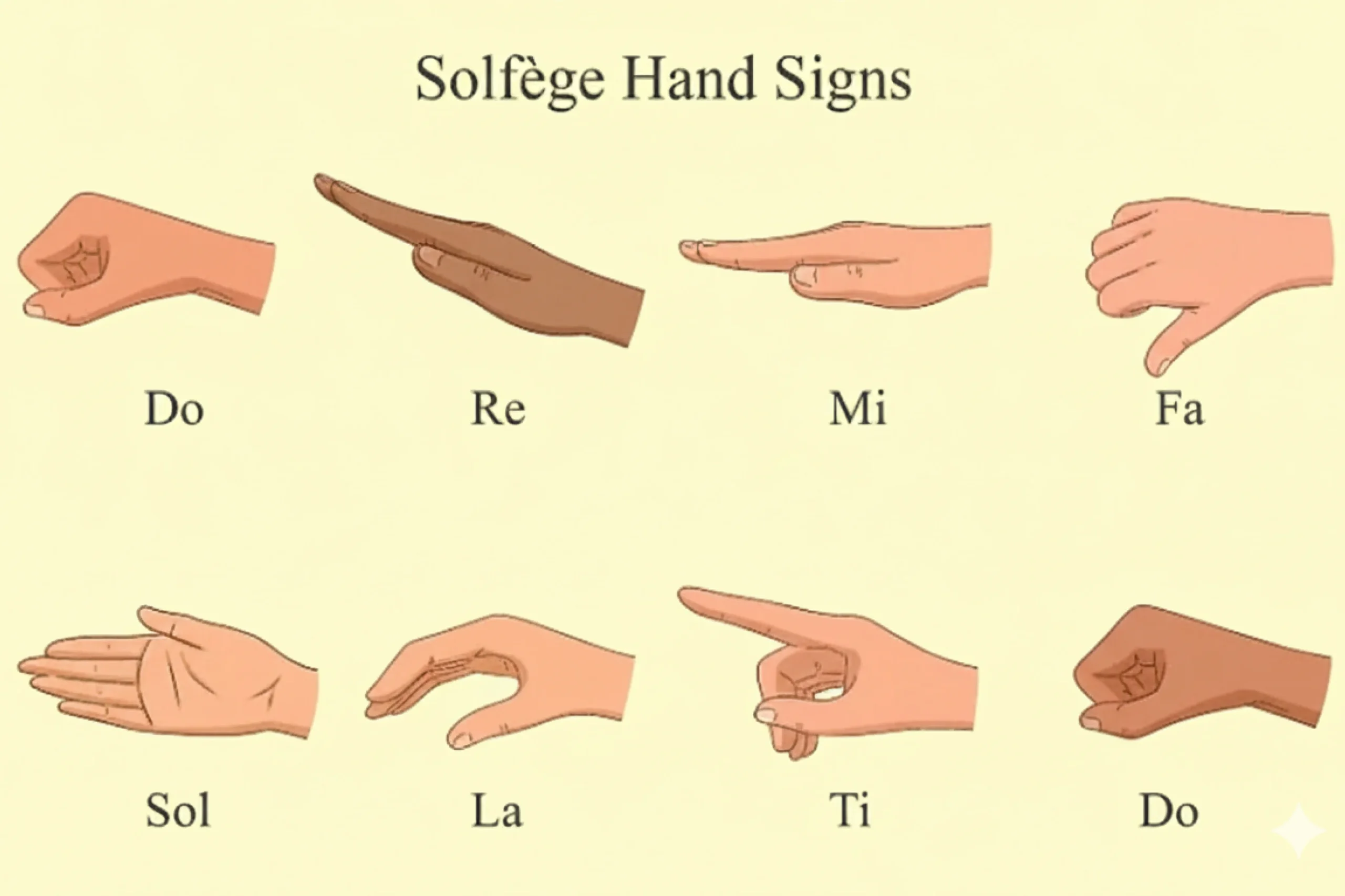All Topics
- Alchemizing Music Concepts for Students
- Artist Spotlight
- artium gift card
- Artium Maestros
- Artium News
- buying guide
- Carnatic Music
- Devotional Music
- Editorials by Ananth Vaidyanathan
- Film Music
- Guitar
- Hindustani Classical Music
- Indian Classical Music
- Indian Folk Music
- Insights
- Instruments
- Karaoke Singing
- Keyboard
- Kids Music
- maestros
- Music Education
- Music for Kids
- Music Industry
- Music Instruments
- Music Legends
- Music Theory
- Music Therapy
- Piano
- piano guide
- Success Stories
- Tamil Film Music
- Telugu Film Music
- Time Theory
- Tools
- Uncategorized
- Vocal Singing
- Vocals
- western classical music
- western music
- Western vocal music
What Is Solfège and Why Is It Used in Music? Learn in Detail
What Is Solfège and Why Is It Used in Music? Learn in Detail

Table of Contents
Music is a universal language. It has the power to surpass geographical boundaries and connect to every human emotion.
But one may wonder, how did musicians learn to speak this language? So fluently?
The answer lies in the timeless and proven method called Solfege.
Solfege is central to music education, from ear training to sight singing; it has helped countless musicians build skills with precision and confidence. Think of it as the bridge between hearing and understanding music.
In this blog, we will explore what Solfege is, where it originated from, and why it is so important in music education. So, if you are a beginner, a hobbyist singer, or a parent looking to guide your child in their musical development, this is your guide to help you understand Solfege and how it builds strong musicianship and vocal confidence.
What Is Solfege?
In plain, simple words, Solfege is a system used to teach pitch and sight-singing. The Solfege uses special syllables, such as “Do,“ “Re,“ “Mi,“ “Fa,“ “Sol,“ “La,“ “Ti,” which represent the notes on the scale. These syllables correspond to a musical pitch and help singers identify and reproduce notes accurately. In Western music, the Solfege syllables represent the major scales. For example, in the key of C major:
Notes: C – D – E – F – G – A – B – C
Solfege Notes: Do – Re – Mi – Fa – Sol – La – Ti – Do
Each of these notes has a distinct emotional role in the scale:
- Do – The “home” note feels grounded and complete
- Re – Feels like taking a gentle step upward
- Mi – Balanced and pleasant
- Fa – Introduces tension or movement
- Sol – Feels bright and open
- La – Emotional and expressive
- Ti – Creates suspense, leading us back to Do.
These syllables form the basis of the Do-Re-Mi scale, the building block of Western music.
A Brief History of Solfege
Solfege was invented in the 11th century by Guido d’Arezzo, an Italian monk and music theorist. Before the invention of Solfege, singers memorized chants entirely by ear, which was a slow and challenging process.
To help singers learn new melodies more efficiently, Guido created a system using syllables from the hymn Ut Queant Laxis, in which each line began on a relatively higher pitch. This is where he derived the notes Do, Re, Mi, Fa, Sol, La, and Ti. This is where the Solfege system originated, making it easy to read and hear music long before the invention of modern notation.
Fixed Do Vs. Movable Do Systems
There are two primary systems in Solfege: Fixed Do and Movable Do. Their usage depends on the musical context and region.
| Fixed Do | Movable Do |
|---|---|
| A syllable corresponds to a specific pitch | “Do” is assigned as the first note of the scale, regardless of key |
| “Do” always represents C | In C Major, Do=C |
| “Re” always represents D | In G Major, Do=G |
| “Mi” always represents E & so on… | Focuses on the relationship between notes |
| Used in classical & European conservatories | Best for ear training and transposing music |
| Helps with pitch recognition & reading complex compositions |
Most online Western vocal classes, including ours, prefer the Movable Do system as it builds stronger relative pitch and adaptability across keys.
Why is Solfege Used in Music Education?
For a musician, Solfege is one of the most important tools to have. It sharpens your musical intuition and helps you connect what you see on a score with what you hear and sing. Here’s why it’s an essential part of music learning:
- Ear Training
Solfege improves the ability to identify pitches and intervals by ear. When you practice Solfege syllables, you train your brain to recognize sound relationships instantly. This is the foundation of ear training, a crucial skill for singers and instrumentalists alike. - Sight- Singing
With Solfege, singers can look at sheet music and sing it accurately without hearing it first. This ability to “hear with your eyes” makes learning new songs or harmonies faster and easier. - Pitch Memory
Practicing Solfege scales regularly builds pitch memory, or the ability to recall and maintain accurate notes. Over time, your mind develops an inner ear, helping you stay in tune effortlessly during performances. - Musicianship Development
Solfege can connect your mind, ear and voice into one seamless unit. It’ll help you build confidence, improve tone quality and deepen your understanding of how music flows.
This is why some of the top professional musicians, from classical singers to pop artists, study Solfege.
How Musicians Use Solfege?
Solfege is not limited to classrooms alone. It is used by everyday singers, composers and instrumentalists.
- Singers – They use it for warm-ups, pitch correction and range expansion.
- Instrumentalists – They use Solfege on piano or guitar to improve coordination and melodic understanding.
- Composers – They hum through Solfege syllables to test melodic lines before writing them down.
You might recall the classic “Do-Re-Mi” scene from The Sound of Music. That song is essentially a lesson in Solfège! It teaches how each syllable corresponds to a note, and how combining them forms beautiful melodies.
Example Exercises:
- Sing Do-Re-Mi-Fa-Sol-Fa-Mi-Re-Do slowly, using a clear tone and hand signs.
- Try patterns like Do-Mi-Sol-Mi-Do to practice interval jumps.
- Play the Do Re Mi scale on a piano while singing along to strengthen pitch accuracy.
Learning Solfege: The Visual Signs
The most effective way to learn Solfege is through hand signs, also known as Curwen hand signs. These signs/gestures represent each pitch, engaging a learner’s visual and physical senses in the learning process.

Using these hand signs can help reinforce muscle memory and connect sound with movement. This is particularly useful when singing in groups or during choir practice.
Benefits of Learning Solfege
Here are some reasons why mastering Solfege is priceless for musicians of all ages:
- Enhances ear training and pitch recognition
By practicing Solfege regularly, you can sharpen the ability to identify and reproduce notes by ear. Over time, you start hearing intervals and melodies internally, an important skill for any musician.
- Improves music reading and sight-singing
Once you learn Solfege, you can easily translate written notes into sound. This makes it easier to sing new songs, harmonies or exercises accurately, even without hearing them first.
- Improves sense of tonal center and key relationships
By learning Do Re Mi scale, you will develop a clear understanding of how notes relate to one another within different keys, making transposing and improvisation much simpler.
- Enhances intonation and prevents off-pitch singing
Singing with Solfege syllables trains your vocal muscles and ear to match correct pitches consistently, helping you stay perfectly in tune during performances.
- Boosts musical confidence and self-expression
Knowing precisely how the notes sound and feel gives singers the confidence to perform freely. Learners can focus on emotion and expression instead of worrying about hitting the right note.
- Encourages active listening and musical awareness
With Solfege, the learner builds an analytical ear. You will start to notice melodies, harmonies, and chord progressions in everyday music, deepening your appreciation and understanding.
- Connects theoretical knowledge with practical singing
Solfege bridges the gap between learning music theory and actually applying it while singing, making practice sessions more meaningful and results-driven.
If you are a parent of an aspiring musician, or a musician yourself, you will notice that practicing Solfege daily develops better musical ability, stronger concentration and auditory memory.
How to Start Learning Solfege?
Here’s a step-by-step guide to getting started with Solfege. Make this part of your daily practice routine:
- Start with the Do-Re-Mi scale. Sing slowly, focusing on correct pitch and clarity.
- Use hand signs, engage your body to strengthen muscle memory.
- Practice Solfege on the piano. Play and sing simultaneously to connect ear and hand coordination.
- Train with easy melodies. Try known tunes like “Twinkle, Twinkle Little Star” or “Do Re Mi” from the movie Sound of Music using Solfege syllables.
- Listen and Repeat. Practice hearing short phrases and reproducing them vocally.
- Join online singing classes. A trained mentor can correct pitch, posture and breathing, thus accelerating your progress.
- Be consistent. Just 10-15 minutes of Solfege practice daily can yield remarkable results over time.
Learning Solfege with Artium Academy
We understand the power of Solfege. It is not just another lesson; it is the key to understanding music from the inside out. That’s why our Western vocals course, curated by the legendary Sonu Nigam, integrates Solfege into each stage of your learning. From music theory basics to advanced ear training and song performance, our structured music curriculum helps you build confidence, pitch accuracy and expressive power.
With our online Western vocal classes, you can practice Solfege exercises, get tailored feedback and master sight-singing, all from your home. So, whether your goal is to become a professional singer or simply enjoy music more deeply, Solfege will help you unlock your true musical potential.
So, for all you aspiring singers dreaming of singing with confidence or wanting to discover your musical voice, Solfege is your go-to exercise. And there’s no better place to start this journey than with Artium Academy.
Book a free 1:1 trial today.
FAQs
It is a music learning system that assigns specific syllables, such as “Do,“ “Re,“ “Mi,“ “Fa,“ “Sol,“ “La,“ “Ti,” and “Do,” to notes in a scale. It helps musicians recognize pitches, sing accurately, and develop a deeper understanding of melody and harmony. Essentially, Solfège gives “names” to musical sounds so you can identify and reproduce them confidently.
The seven Solfège syllables are Do, Re, Mi, Fa, Sol, La, and Ti. Each syllable corresponds to a step of the major scale. When you return to “Do,” you complete the octave, making it Do, Re, Mi, Fa, Sol, La, Ti, Do. These syllables form the foundation of the Do-Re-Mi scale that every singer learns.
The word Solfège originates from the Italian terms sol and fa, which were part of an early Latin hymn used by Guido d’Arezzo, an 11th-century monk who developed the system. Over time, the term evolved to describe the entire pitch-training method that helps musicians learn and sing by syllables.
Solfège singing is the practice of vocalising scales, melodies, or songs using Solfège syllables instead of lyrics. For example, instead of singing words, you sing “Do-Re-Mi-Fa-Sol.” This technique enhances ear training, pitch accuracy, and sight-singing skills essential for both beginner and advanced singers.
In Indian classical music, a similar system exists called Sargam, where the syllables are Sa, Re, Ga, Ma, Pa, Dha, Ni. Just like Western Solfège, these syllables represent the notes of a scale and are used to train the ear and voice for accuracy. Both systems share the same purpose: helping musicians connect sound, note, and emotion.
When including sharps and flats, Solfège covers all twelve chromatic notes:
Do, Di/Re♭, Re, Ri/Mi♭, Mi, Fa, Fi/Sol♭, Sol, Si/La♭, La, Li/Ti♭, Ti, Do. These variations enable singers to practice every half-step in the Western musical scale, thereby improving their versatility and control across different keys.
You can explain Solfège to children as a way of giving names to musical sounds. For example, “Do” is home, “Re” climbs a step, and “Mi” smiles in the middle. Singing the Do-Re-Mi song from The Sound of Music is a fun and interactive way for kids to grasp the concept while learning pitch and rhythm naturally.
Solfège is vital because it connects your ears, voice, and brain, the three pillars of musicianship. It trains your ear to recognize notes, your voice to reproduce them accurately, and your mind to understand their relationships. Whether you’re a beginner, a student, or a performing artist, mastering Solfège builds a solid foundation for confident singing and a deeper understanding of music.







